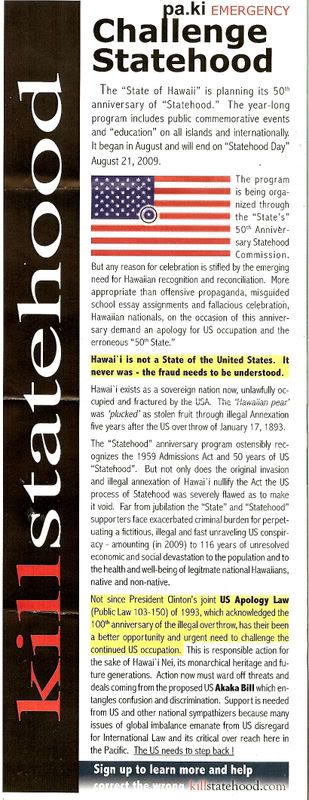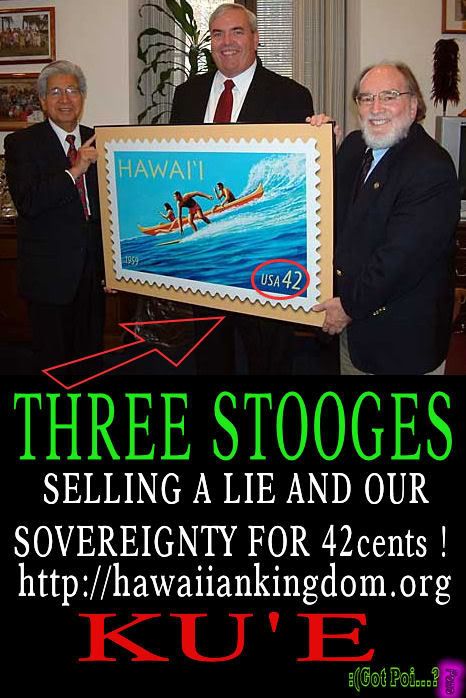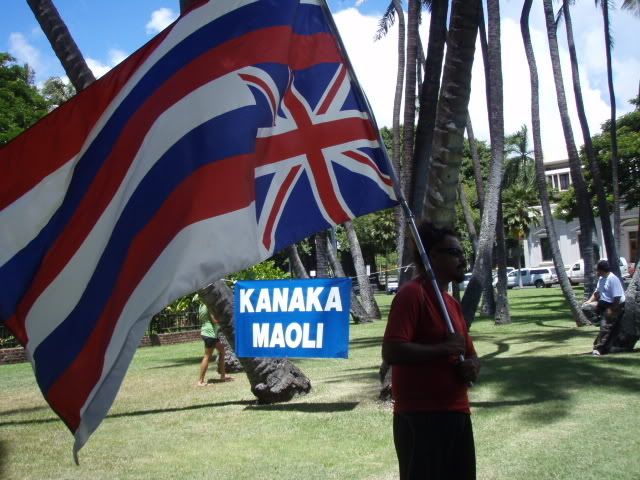All Posts (6434)
Support KAHEA and get a Sustainable, Local-grown Christmas Tree!
Order your 6-foot tree online today! Only $40 for a beautiful, fresh 6-ft tall Norfolk pine! KAHEA will receive $7 from Helemano Farms for each tree sold--and more if we sell over 200 trees--we need your help!
Then, come party with us! Come by our annual Mahalo Pau Hana party on the rooftop balcony at thirtyninehotel art gallery & bar (39 N. Hotel St.) in Honolulu's Chinatown on December 10 at 5:30PM.
---------------
The work that KAHEA accomplishes is possible only through the support of individuals like you! KAHEA is committed to fundraising 'taroroots'-style. And in the spirit of keeping it real, KAHEA does not solicit or accept any corporate or Federal money. This makes your support all the more important!
Mahalo to all who give!
You can support KAHEA's work by making a contribution online at www.KAHEA.org or by mail to 1149 Bethel St, #415, Honolulu, HI 96813.
Every dollar you give is matched by the Earth Friends Wildlife Fund.
MAHALO PIHA!
Aloha Kakou!
O'ahu's ONLY Christmas-tree farm, Helemano Farms in Wahiawa, has generously offered KAHEA an opportunity to fundraise by selling pono, locally grown Christmas trees during this holiday season... a 6-ft tree for only $40!
Why buy a locally grown tree from KAHEA? A few perfect reasons:
- Each year 100,000 trees are shipped to Hawai'i in some 500 container loads.
- By buying local, there is no fossil fuel used for shipping. Locally-grown also means there is no chance of introducing invasive pests.
- Your 'ohana gets to enjoy the tradition of picking out your own fresh tree, choosing from 10,000 mature trees in the orchard.
- Helemano Farms is careful to cut the trees so that the remaining stump will regrow into another tree.
- Your purchase goes to help KAHEA in protecting all that we love about Hawai'i nei-- and supports a sustainable, local farm business!
Only $40 for a beautiful locally-grown, 6-ft. tall christmas tree!
Please spread the word to all your family, friends & office--
Help KAHEA fundraise this holiday season!
KAHEA will get $7 for each tree we sell!
HOW TO ORDER:
You can order online with visa or mastercard: https://salsa.democracyinaction.org/o/2699/shop/shop.jsp?storefront_KEY=583
You can order by phone: visa and mastercard orders accepted by phone, call KAHEA toll-free at 1-888-528-6288
You can order by mail: Make out your check to "KAHEA", with "Christmas Tree" in the memo section.
Send your check to:
KAHEA/Christmas Tree
1149 Bethel St, #415
Honolulu, HI 96813
How to pick up your tree:
(1) For all orders KAHEA will send you a ticket in the mail that you redeem at the farm whenever you are ready to go pick out your tree.
(2) Helemano Farms will be open for tree selection starting Nov. 26. You can order your tree from KAHEA now! Click here for directions to Helemano Farms.
**Please note: KAHEA is only selling tree orders, you get to pick out your own tree at Helemano Farms in Wahiawa. KAHEA cannot deliver the trees or sell them directly.
Mahalo piha to the Helemano 'ohana for sharing the holiday cheer with KAHEA!
ORDERS & QUESTIONS- Call or email KAHEA:
toll free 1-888-528-6288
kahea-alliance@hawaii.rr.com
For more info, www.HelemanoFarms.com and www.KAHEA.org.
Like to PARTY? Us too!
We love the holiday season because it's also when we get to put down the stacks of testimony, step away from the laptops and throw a sweet party for YOU--our amazingly supportive and caring 'ohana!
Please come by our annual Mahalo Pau Hana party on the rooftop balcony at thirtyninehotel art gallery & bar (39 N. Hotel St.) in Honolulu's Chinatown on December 10 at 5:30pm. Save the date!
Ono pupus, cash bar, and our very favorite music stars, Kupa'aina! Also, fine art by Native Hawaiian artists, gift-worthy KAHEA t-shirts and art-n-advocacy posters.
This is also a time of fun(ds) for us too-- come help us continue to do all that we do for the people & 'aina of Hawai'i! We do it all without accepting any corporate or Federal money. We rely on you--grassroots style! Tickets are a suggested donation of $20.
Much love and mahalos to www.SolomonEnosGallery.com and www.Kupaaina.com.
------------------------------------------
KAHEA is an islands-wide alliance of environmental advocates, Native Hawaiian cultural practitioners, scientists, activists and thousands of individuals. Together, the KAHEA alliance is committed to securing the strongest possible protections for Hawaii's most ecologically important, endangered, and culturally sacred resources.
please visit us at www.kahea.org & blog.kahea.org




..Traditional Hawaiian ocean sports are depicted on a new postage stamp unveiled yesterday in Washington, D.C.
The stamp, designed by Hawaii artist and historian Herb Kane, will be released in August to commemorate Hawaii's 50th anniversary of statehood.
A surfer on a longboard and two paddlers in an outrigger canoe are depicted riding a wave to shore on the stamp of vivid blue, red and gold.
U.S. Postmaster General John Potter gave U.S. Sen. Daniel Akaka and U.S. Rep. Neil Abercrombie a preview of the design.
"Celebrating our statehood in 1959, the symbolism is powerful, portraying a people set on course for a prosperous life in the new state of Hawaii," Akaka said in a news release.
President Dwight D. Eisenhower signed a proclamation naming Hawaii the 50th state on Aug. 21, 1959, following approval by Congress and a plebiscite of Hawaii citizens.
Abercrombie said, "Herb Kawainui Kane has done a masterful job of expressing the beauty and energy of Hawaii's special relationship with the sea."
The stamp will be formally announced next month when the U.S. Postal Service unveils its 2009 stamp designs.
A special First Day of Issue event will be held in Honolulu in August.
.. ..Traditional Hawaiian ocean sports are depicted on a new postage stamp unveiled yesterday in Washington, D.C.
The stamp, designed by Hawaii artist and historian Herb Kane, will be released in August to commemorate Hawaii's 50th anniversary of statehood.
A surfer on a longboard and two paddlers in an outrigger canoe are depicted riding a wave to shore on the stamp of vivid blue, red and gold.
U.S. Postmaster General John Potter gave U.S. Sen. Daniel Akaka and U.S. Rep. Neil Abercrombie a preview of the design.
"Celebrating our statehood in 1959, the symbolism is powerful, portraying a people set on course for a prosperous life in the new state of Hawaii," Akaka said in a news release.
President Dwight D. Eisenhower signed a proclamation naming Hawaii the 50th state on Aug. 21, 1959, following approval by Congress and a plebiscite of Hawaii citizens.
Abercrombie said, "Herb Kawainui Kane has done a masterful job of expressing the beauty and energy of Hawaii's special relationship with the sea."
The stamp will be formally announced next month when the U.S. Postal Service unveils its 2009 stamp designs.
A special First Day of Issue event will be held in Honolulu in August.
.... http://www. starbulletin. com/news/20081118_Isle_statehood_stamp_features_ocean_sports. html

 Get Your Own UnKau Inoa T-ShirtHere's How - UnKauInoa.OrgDo It Today!
Get Your Own UnKau Inoa T-ShirtHere's How - UnKauInoa.OrgDo It Today!
Please spread the word.
|
 Read More Details Here
Read More Details Here

